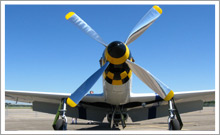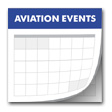| SPONSOR |  | TRAINING TIPs  Your ‘right’ flyer Your ‘right’ flyer Here is a question for this 107th anniversary of powered flight. Which airplane is more challenging to fly: your modestly equipped, low-powered trainer, or that high-performance aircraft parked nearby? Bells and whistles (of the fancy aircraft) aside, your trainer is probably more of a project to simply fly by hand. That’s why what your trainer lacks in glamour, it makes up for in how it teaches you about flying. Let’s start with a “spec.” The specification of “wing loading” from your pilot’s operating handbook is probably a lower number (in pounds per square foot) than that of the high-performance aircraft. “Wing loading is a way of expressing how much weight each square foot of wing area must lift, and is usually given at the aircraft's maximum gross weight,” explained the Oct. 21, 2005, “ Training Tip: Wing loading.” Lower wing loading makes your aircraft bouncier in rough air, which teaches you how to fly in turbulence and gives you something to look forward to—smoother rides in advanced aircraft—later. In bumps or smooth air, flying is easier if you establish the desired flight condition and trim for hands-off flight, as shown in this October 2010 Flight Training article and video. Elevator trim may be your trainer’s only trim control. “At the other end of the spectrum, pilots training in highly automated machines such as technologically advanced aircraft (TAA) know trim as one component of an integrated system,” said the July 3, 2009, “ Training Tip: Trainers and Trim.” Another system you may encounter someday is a constant-speed propeller. It is designed to maximize propeller efficiency in both climbs and cruise—freeing a pilot from certain trainer trials: “Flying maneuvers or through air burdened with up- and downdrafts is smoother and more comfortable with a constant-speed prop because, as the air load changes on the prop, its governor compensates to maintain the rpm. Under similar conditions, a fixed-pitch prop speeds up and slows down erratically, transmitting vibrations to the cockpit (and its occupants), often luring inexperienced pilots into chasing the fluctuating rpm with inefficient—and ineffective—power and trim adjustments,” said the January 2006 Flight Training magazine feature “ Smooth Operator.” Trainers work hard. They’re built to last a long time, and to teach lessons that last even longer. YOUR PARTNER IN TRAINING Are snow and ice making an appearance at your airport? Do you know how to conduct ground operations on runway and taxiway surfaces that may have ice or snow? This article from the November 2002 Flight Training offers helpful tips for starting your airplane in cold weather and advice to keep you from slip-sliding away. For more, see the Air Safety Institute’s Cold Weather Operations Safety Spotlight. Did you know that student pilots who join AOPA are three times more likely to complete their flight training? Membership includes unlimited access to aviation information by phone (800/USA-AOPA, weekdays from 8:30 a.m. to 6 p.m. Eastern time) or from Flight Training Online or AOPA Online. If you're not already a member, join today and get the pilot's edge. Login information is available online. FLIGHT TRAINING NEWS Embry-Riddle hypoxia training open to pilots Until recently, if a pilot wanted to learn how he or she reacted to the effects of hypoxia, it meant signing up for a shot at the military’s few hypobaric altitude chambers scattered throughout the country. Now Embry Riddle Aeronautical University in Daytona Beach, Fla., has its own normobaric “altitude chamber” that’s open to the public. Read more >> No reg changes planned for CFI renewals No regulatory changes are planned for the flight instructor refresher clinic (FIRC) and CFI renewal process, the FAA confirmed during meetings to solicit recommendations for improving the system, held Dec. 6 and 7. The agency had expressed concern over the general aviation safety record and asked for input on whether regulatory requirements for CFI renewals should be changed, among other questions. Read more >> Heed the Air Safety Institute’s advice: Ice isn’t nice Your instructor will have told you ice in flight is bad news. It destroys the smooth flow of air, increasing drag while decreasing the ability of the airfoil to create lift. With freezing temperatures covering much of the United States this season, you’ll want to be keenly aware of the potential for encountering icing conditions in flight. Download the Air Safety Institute’s Aircraft Icing Safety Advisor to learn how to anticipate areas of probable icing and get tips on how to avoid this potentially deadly foe. Download the advisor >> Sporty’s shares tips for flight school success Sporty’s Academy, a participant in AOPA’s Flight Training Summit, is sharing tips that can help other flight schools to improve their retention and student completion rates. For example, in recognition of the fact that many students are pursuing flight training purely for recreational purposes, Sporty’s offers a modular training approach that is not focused solely on obtaining a private pilot certificate. Training is broken down into steps (solo and recreational; transition to private pilot) that students view as obtainable. These and other tips are available on the Sporty’s website. IFR Mastery Series offers online, scenario-based training PilotWorkshops.com has created a new course specifically for instrument-rated pilots that offers online, scenario-based training. The IFR Mastery Series is a continuing series of monthly workshops in which IFR instructors analyze common situations that can lead pilots to trouble. Participants choose their course of action via an online survey and can compare their decisions to those of other pilots. The course is available in two formats: online only ($29 per month), or online and monthly CD ($49 per month). For more information, see the website. Inside AOPA Learn runway signs, markings the easy way Ever find yourself feeling unsure about what a particular runway sign or pavement marking means? The Air Safety Institute’s free Runway Safety Flash Cards can help. The front of each card displays a typical sign or marking, while the back identifies it, places it in context, and explains what to do if you see it. Download and print the cards >> Holiday shopping made easy Shop from the comfort of your home with the AOPA Lifestyles Collection. Choose from a vast selection of items from top retailers such as Best Buy, Harry & David, Wal-Mart, Bass Pro Shops, and Omaha Steaks. When you shop through the AOPA Lifestyles Collection, you’ll also be giving a gift to general aviation with each item you buy. A percentage of each sale is returned to AOPA and reinvested to fund the association’s mission to maintain the freedom, safety, and affordability of GA. LifeLock tips to keep your info safe It’s the season of giving—but are you about to give more than you bargained for? Retail transactions require your sensitive information. Find out eight tips to keep your identity safe while shopping online and in brick-and-mortar stores. Read more >> TRAINING PRODUCTS King Schools courses on iPhone Study a variety of King Schools courses on your iPhone, iPod Touch, or iPad. Five courses are available as iPhone applications: Stalls and Spins, VFR Cross Country, Pilot Communications, Complete Airspace, and Takeoffs and Landings. Each is priced at $29.99. Download from the iTunes Store. Note: Products listed have not been evaluated by ePilot editors unless otherwise noted. AOPA assumes no responsibility for products or services listed or for claims or actions by manufacturers or vendors. FINAL EXAM Question: I am a student pilot and only fly by myself in day VFR conditions. Is spatial disorientation something that I need to be concerned about or does it really only happen to instrument-rated pilots in instrument meteorological conditions (IMC)? Answer: Yes, you certainly do need to be aware of the possibility of becoming spatially disoriented while flying. VFR-only pilots are the most frequent victims of spatial disorientation. Several years ago the Air Safety Institute conducted a study of spatial disorientation accidents that occurred during a 10-year period and found that 50 percent resulted from VFR pilots flying into IMC. This situation is fatal 90 percent of the time. For more information, read the Air Safety Institute’s Safety Advisor, Spatial Disorientation: Confusion that Kills . Got a question for our technical services staff? E-mail [email protected] or call the Pilot Information Center, 800/872-2672. Don’t forget the online archive of “Final Exam” questions and answers, searchable by keyword or topic. AOPA Career Opportunities Ever dream of turning your passion for aviation into a career? We’re looking for a business analyst and financial analyst. To learn more about other AOPA career opportunities, visit AOPA Online. Picture Perfect  Pilots love to take photos, and they love to share them with other pilots. Now you can upload your flying photos to our online gallery, “Air Mail.” Share your special aviation images, or view and rate more than 7,000 photos (and growing). Photos are put into rotation on the AOPA home page! Pilots love to take photos, and they love to share them with other pilots. Now you can upload your flying photos to our online gallery, “Air Mail.” Share your special aviation images, or view and rate more than 7,000 photos (and growing). Photos are put into rotation on the AOPA home page! AVIATION EVENTS & WEATHER  Want something to do this weekend? Planning an aviation getaway? See your personalized online calendar of events . We’ve enhanced our calendar so that with one click you can see all of the events listed in the regions you selected when personalizing ePilot . Now you can browse events in your region to make planning easier. You can also bookmark the personalized calendar page to check it as often as you want. Before you take off on an adventure, make sure you check our current aviation weather provided by Jeppesen. Want something to do this weekend? Planning an aviation getaway? See your personalized online calendar of events . We’ve enhanced our calendar so that with one click you can see all of the events listed in the regions you selected when personalizing ePilot . Now you can browse events in your region to make planning easier. You can also bookmark the personalized calendar page to check it as often as you want. Before you take off on an adventure, make sure you check our current aviation weather provided by Jeppesen. To include an event or to search all events in the calendar, visit AOPA Online. For airport details, including FBO fuel prices, see AOPA Airports. Flight Instructor Refresher Clinics The next Air Safety Institute Flight Instructor Refresher Clinics are scheduled in Long Beach, Calif., and San Antonio, Texas, Jan. 8 and 9; Jackson, Miss., and Portland, Ore., Jan. 15 and 16; Baltimore, Md., Detroit, Mich., and Charlotte, N.C., Jan. 22 and 23; San Jose, Calif., Sevierville, Tenn., and Bellevue, Wash., Jan. 29 and 30. For a complete schedule, see AOPA Online. Can’t make it in person? Sign up for the CFI Refresher Online. Air Safety Institute Safety Seminars Air Safety Institute Safety Seminars are scheduled in Mesa, Ariz., and Reno, Nev., Jan. 10; Tucson, Ariz., and Sacramento, Calif., Jan. 11; Milpitas, Calif., Jan. 12; Santa Rosa, Calif., Jan. 13; San Diego, Calif., and Fort Worth, Texas, Jan. 24; Costa Mesa, Calif., and Houston, Texas, Jan. 25; Ontario, Calif., and San Antonio, Texas, Jan. 26; Austin, Texas, Jan. 27. Topics vary—for details and a complete schedule, see AOPA Online. | Advertisers           Got news? Contact ePilot. Having difficulty using this service? Visit the ePilot Frequently Asked Questions now at AOPA Online or write to [email protected].
421 Aviation Way
Frederick, MD 21701
Tel: 800/USA-AOPA or
301/695-2000
Copyright © 2010 AOPA.
|

 Your ‘right’ flyer
Your ‘right’ flyer
